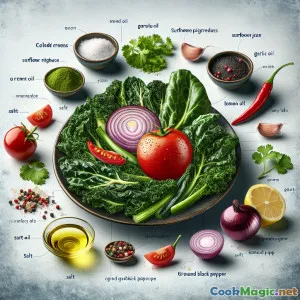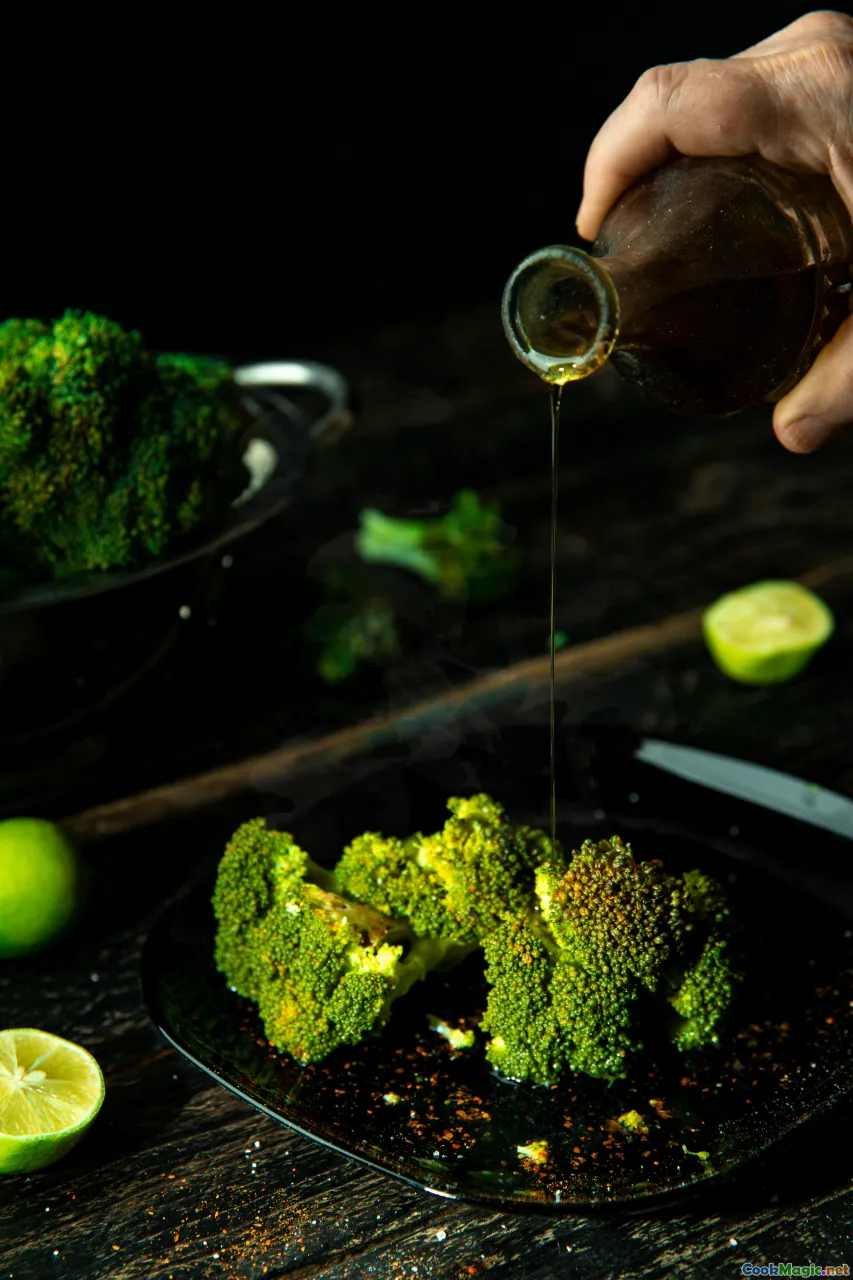
Hızlı Sukuma Wiki Kavurması Keskin Soğanlarla
(Quick Sukuma Wiki Stir Fry with Zesty Onions)
(0 Yorumlar)0
866
Ağustos 02, 2025
Bir Sorun Bildir
Malzemeler
-
250 grams Karaot (Sukuma Wiki)
(Washed and finely shredded)
-
1 medium Kırmızı soğan
(İnce dilimlenmiş)
-
1 medium Domates
(Küp küp doğranmış)
-
2 cloves Sarımsak dişleri
(Kıyılmış)
-
2 tablespoons ayçiçek yağı
(Can substitute with canola oil)
-
1 tablespoon Limon suyu
(Fresh, for a tangy finish)
-
1 small taze biber
(Sliced, for heat (omit for mild))
-
1/2 teaspoon Tuz
(Damak tadına göre)
-
1/4 teaspoon Özütülmüş karabiber
(Damak tadına göre)
-
2 tablespoons Kişniş
(İnce kıyılmış, süsleme için)
(Washed and finely shredded)
(İnce dilimlenmiş)
(Küp küp doğranmış)
(Kıyılmış)
(Can substitute with canola oil)
(Fresh, for a tangy finish)
(Sliced, for heat (omit for mild))
(Damak tadına göre)
(Damak tadına göre)
(İnce kıyılmış, süsleme için)
Besin Değerleri
- Porsiyon: 2
- Porsiyon Boyutu: 1 tabak (250g)
- Calories: 120 kcal
- Carbohydrates: 0 g
- Protein: 6 g
- Fat: 5 g
- Fiber: 5 g
- Sugar: 5 g
- Sodium: 420 mg
- Cholesterol: 0 mg
- Calcium: 180 mg
- Iron: 2.6 mg
Talimatlar
-
1 - Prep the Vegetables:
Wash, dry, and finely shred collard greens. Thinly slice onion, dice tomato, and mince garlic.
-
2 - Sauté Onions and Garlic:
Heat oil in a wide skillet over medium heat. Add sliced onion and sauté for 2-3 minutes till soft. Stir in garlic and cook for another minute.
-
3 - Add Tomato and Chili:
Add diced tomato and fresh chili (if using). Cook for 2 minutes until tomatoes soften.
-
4 - Cook Sukuma Wiki:
Add collard greens in batches, stirring continuously. Sprinkle with salt and black pepper. Sauté for 3-4 minutes until the greens are wilted and vibrant.
-
5 - Finish and Serve:
Remove from heat. Drizzle with lemon juice (if using). Garnish with cilantro. Serve hot as a side or base for grilled meat or ugali.
Wash, dry, and finely shred collard greens. Thinly slice onion, dice tomato, and mince garlic.
Heat oil in a wide skillet over medium heat. Add sliced onion and sauté for 2-3 minutes till soft. Stir in garlic and cook for another minute.
Add diced tomato and fresh chili (if using). Cook for 2 minutes until tomatoes soften.
Add collard greens in batches, stirring continuously. Sprinkle with salt and black pepper. Sauté for 3-4 minutes until the greens are wilted and vibrant.
Remove from heat. Drizzle with lemon juice (if using). Garnish with cilantro. Serve hot as a side or base for grilled meat or ugali.
Hızlı Sukuma Wiki Kavurması Keskin Soğanlarla :Hakkında Daha Fazlası
Sukuma Wiki Greens Stir Fry: Vibrant Kenyan Comfort Food
'Sukuma wiki' translates literally as 'to stretch the week' in Swahili, embodying the resilience and ingenuity of Kenyan home cooking. A staple on East African tables, sukuma wiki measures strength, tradition, and economy in one delightful vegetable stir-fry. At its core, it is a dish designed to make simple, affordable ingredients feed a family for a few more days, with collard greens (often called sukuma wiki) as its heart.
Bright, robust, and lightning-fast to prepare, this version is a love letter to Kenyan cuisine’s efficiency. Collard greens are one of the healthiest vegetables on the planet: brimming with vitamins A, C, K, calcium, fiber, and rich plant compounds. They're shredded very finely, almost slivered, so that the greens cook not only quickly but also retain texture and some bite, rather than wilting into mush. The slight bitterness of the greens is gently tempered by the natural sweetness of soft, sautéed red onions and tangy tomatoes. As in any good stir-fry, balancing fast frying with fresh flavor is key – so quick hands and a hot pan deliver a chorus of color, aroma, and taste.
While often eaten simply with ugali (the staple maize meal) or as a companion to meat stews and fried proteins, sukuma offers flexibility. Drizzle with lemon for zing, slice in chili for heat, or scatter vibrant cilantro on top before serving. For even more local fun, leftover sukuma can fill chapati wraps, top rice bowls, or feature next to roasted sweet potatoes.
Tips & Notes
- Control the cook: Overcooked greens lose their beautiful shade and crunch. Aim to keep sukuma wiki just tender and green.
- Spice it up: Though traditional recipes are mild, you can bring ‘fire’ with fresh chili peppers.
- Lemon lift: Add fresh lemon juice after cooking for extra brightness, or a dash of vinegar if lemons aren’t on hand.
- Versatile base: Stir in cooked beans, add a sprinkle of roasted peanuts, or use as filling for wraps.
- Garnishes: Fresh cilantro offers color and a hit of freshness – parsley works too.
- Make it a meal: For a complete Kenyan experience, serve sukuma wiki beside hot ugali and kienyeji chicken, or slip it into your favorite grain bowls.
History and Cultural Significance
Collard greens are a cornerstone of affordable nutrition and an integral part of Kenyan and wider East African cooking. The dish itself is born from practicality, commonly enjoyed for breakfast, lunch, or dinner. Street vendors often offer it alongside stewed meats, while home cooks make huge batches to last across several meals. Sukuma wiki, whatever the variations, reflects culinary resourcefulness; families, especially in urban and rural Kenya, have relied on these durable greens for years when resources are stretched thin.
Its social role goes beyond nourishment. Sukuma wiki brings people together around the table, often accompanied by stories and laughter. It is an everyday reminder of the joys of simplicity: good food, health, and shared tradition.
Unique Aspects
- Frugality with flair: The concept around sukuma wiki stretches not just food but imagination, showcasing how cuisine adapts across times of plenty and scarcity.
- Ultra-nutritious: Few dishes provide such abundant vitamins for so little cost, making it ideal for a healthy, plant-based diet.
- Global adaptability: Try the recipe with kale, Swiss chard, or mustard greens if collards are hard-to-find locally.
Personal Thoughts
I find sukuma wiki endlessly inspiring for weeknight meals. The visual appeal of emerald greens, the wafting steamy onions, and the quick, nutritious nature of the dish make it an unbeatable side or center show—even outside its Kenyan heritage. It always impresses when time is short and health matters. Give it a twist with whatever’s in the garden or pantry for your own signature version, and it might just stretch your week in delicious new ways.




















